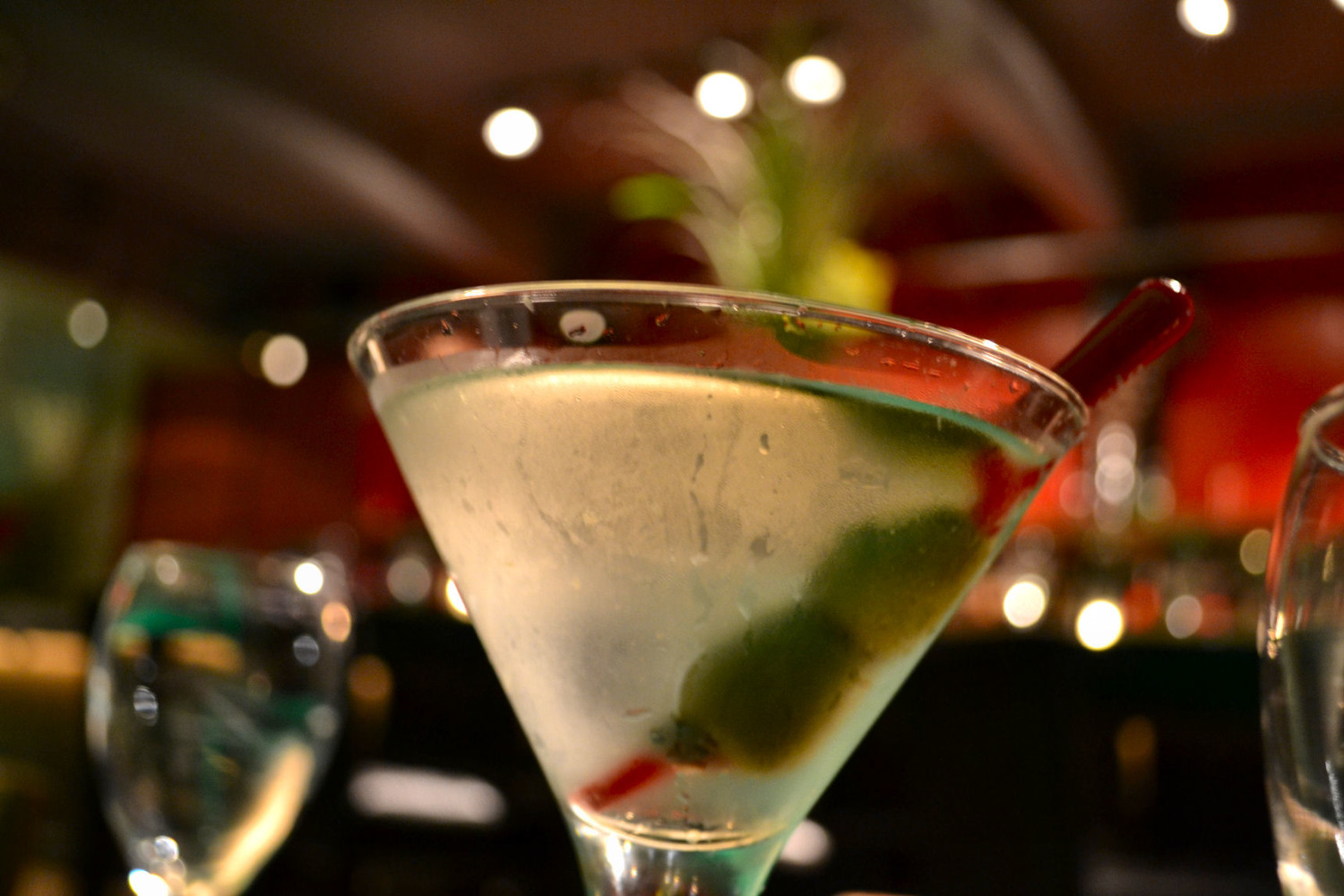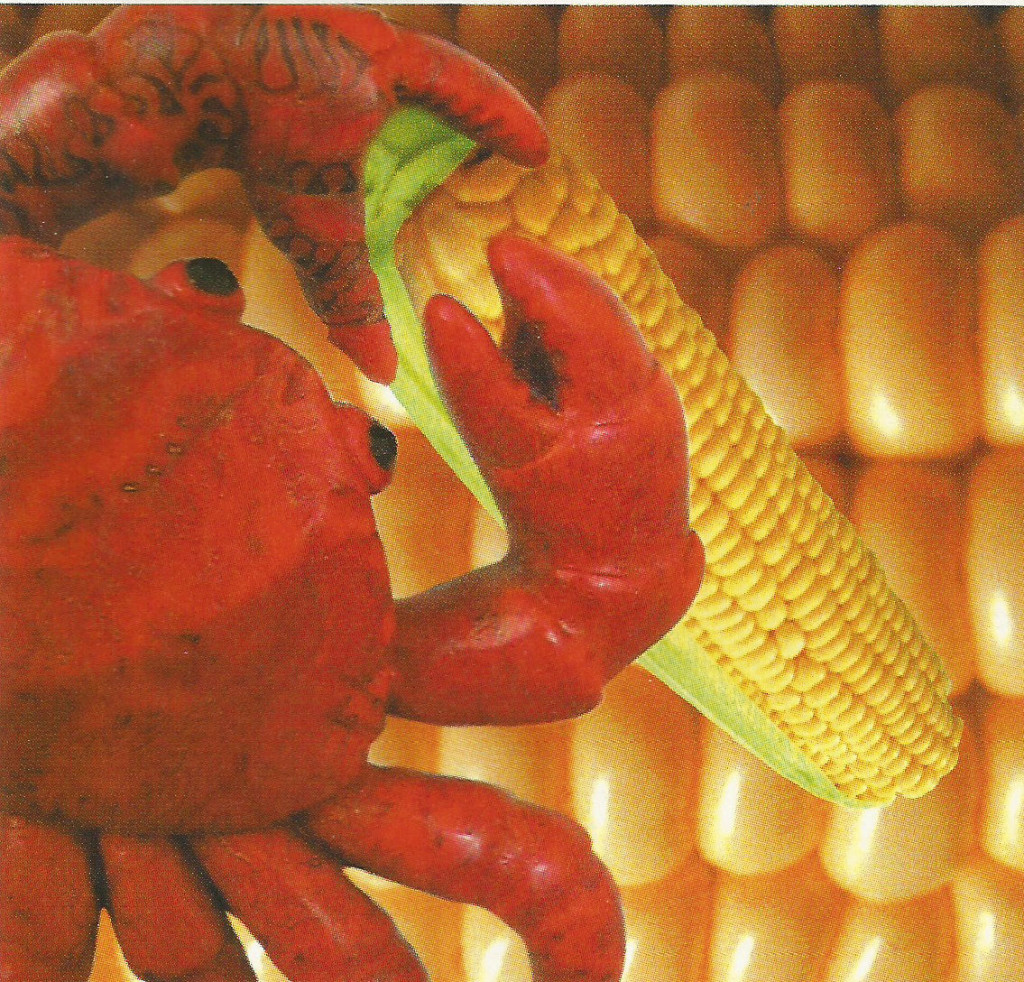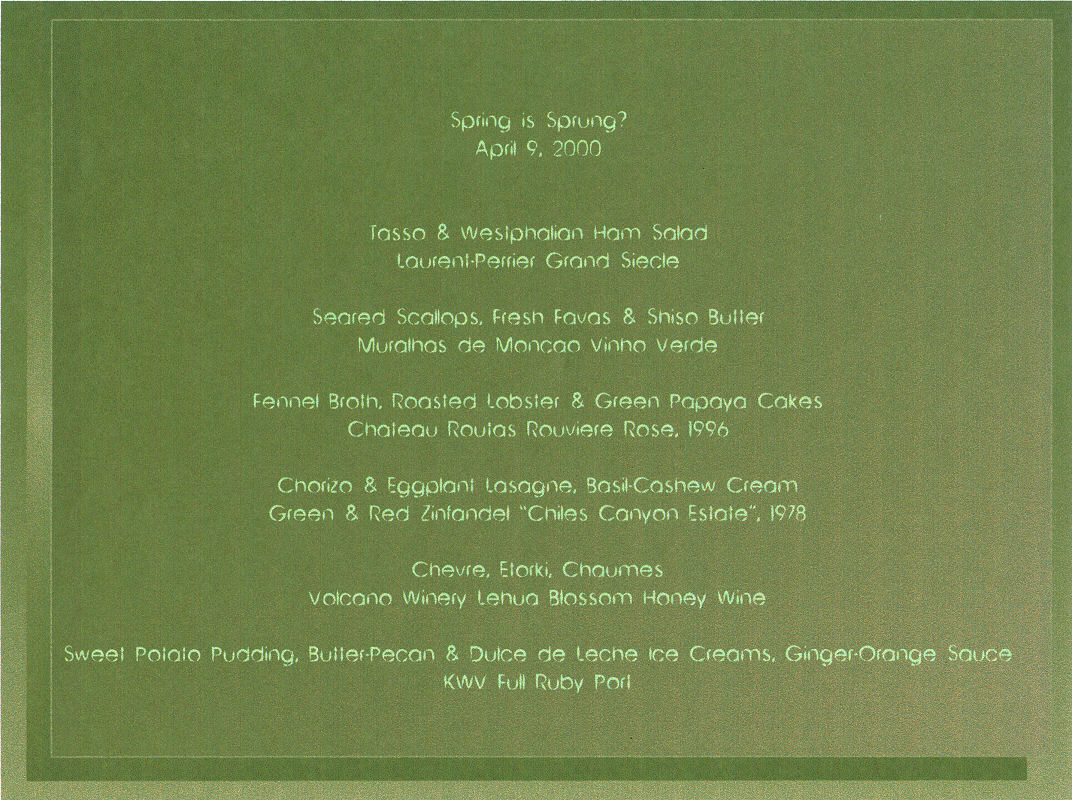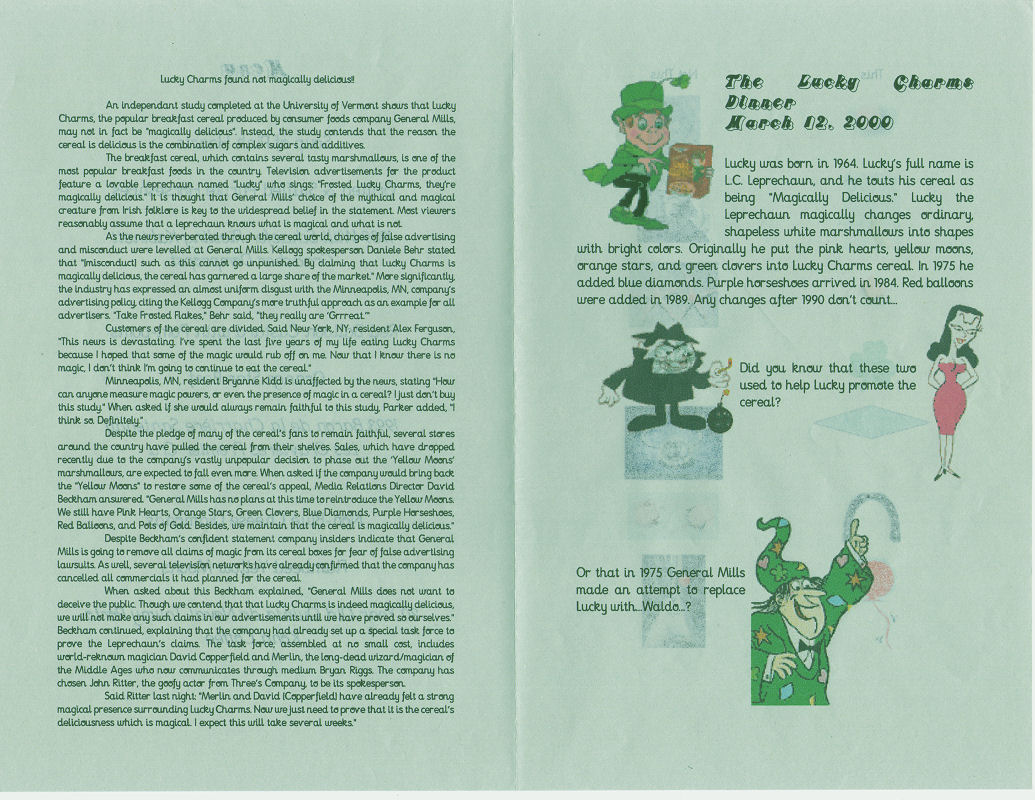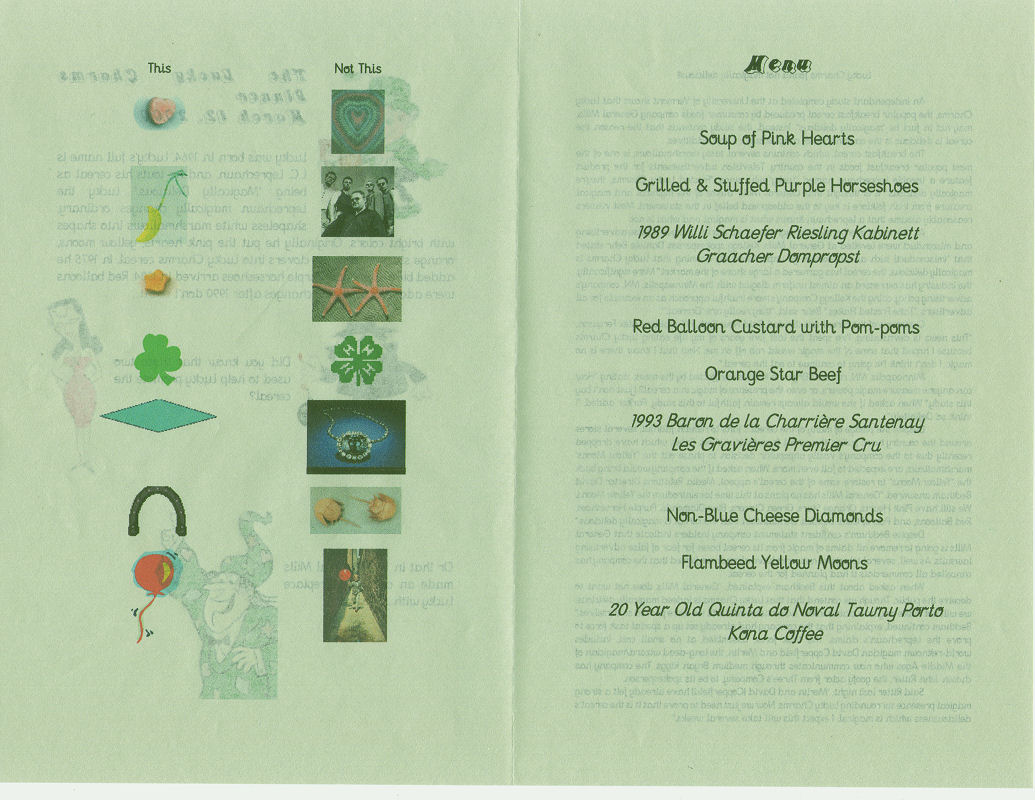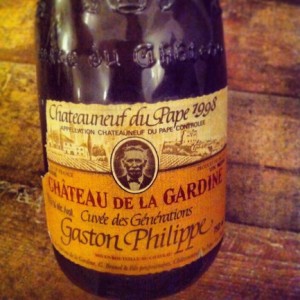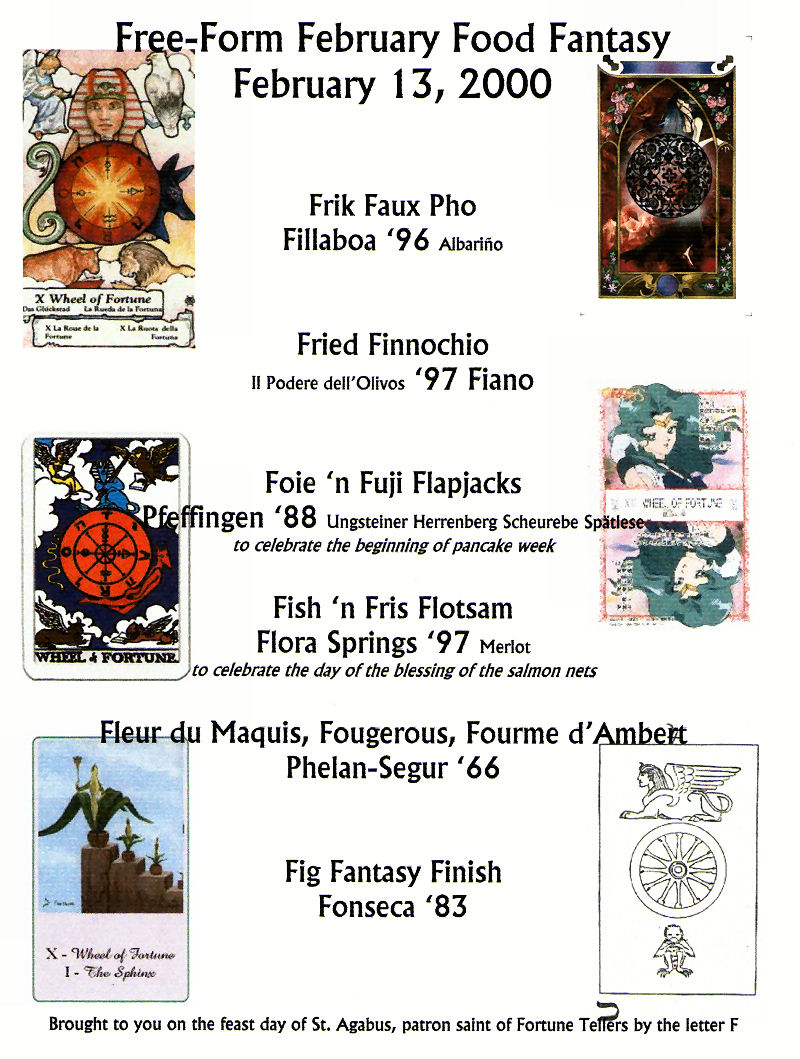Santé
The Magazine for Restaurant Professionals
May-June 2000
Pages 80-82
Beaujolais: Gamay at its Best
Twice while I worked for Santé, I was asked to do all the tasting and write-ups of tasting notes, for articles written by other writers, in this case Rob Costantino. I remember it seemed odd both times that the author wasn’t tasting the wines they were referencing in the article, but hey, I got to taste lots of wines.
Reviewer’s Choice
Coudert / 1998 Fleurie Clos de la Roilette
Dark berry fruit, a touch of smoke and geraniums. A great selection with game fowl and darker poultry dishes.
Domaine Manoir du Carra / 1998 Non-Filtre
Allspice, berries, Moreno cherries and just a touch of smoke make this a great choice for grilled meats.
Louis Jadot / 1998 Moulin-à-Vent Château des Jacques
Cinnamon sticks, cloves, cocoa and orange peel, with a good does of cherries underneath. Perfect with seared pork dishes.
BEAUJOLAIS
VALUE
Pierre et Paul Duridilly
1998 Les Grandes Coasses
Upfront tobacco and blackberry aromas; good, long finish. Delightful on its own or with a grilled T-bone steak. [Michael Skurnik Wines, 516-677-9300, $88/case]
Domaine Madone
1998 Le Perreon
Very forward grapy flavors but slightly green; a trifle hot on the finish. A good, basic “burger” wine. [Michael Skurnik Wines, 516-677-9300, $96/case]
Olivier Ravier Signé
1998 Domaine des Sables d’Or
Raspberries, white pepper and a touch of green stemminess. A simple and basic quaffing wine. [Serge Doré Selections, 914-243-7950, $54/case]
BEAUJOLAIS-VILLAGES
VALUE
Bouchard Père & Fils
1998 Le Chamville
Sweet cherry fruit, with a touch of cinnamon oil that works well with spicy sausage dishes. [Clicquote, Inc., 212-888-7575, $85/case]
Domaine Manoir du Carra
1998 Non-Filtre
Allspice, berries, Moreno cherries and just a touch of smoke make this a great choice for grilled meats. [Kysela Père et Fils, Ltd., 540-722-9228, $80/case]
Georges Duboeuf
1998 Flower Label
White pepper and wild raspberries with a good amount of depth. Delightful with simple veal dishes. [W.J. Deutsch & Sons, Ltd., 914-273-1221 / Winesellers, Ltd., 847-679-0120, $42/case]
Jaffelin
1998
Smoked meats, red cherries and a touch of light spice. Perfect with a charcuterie plate. [Rémy Amerique / Premiere Wine Merchants, 212-399-4200, $80/case]
Jean-Claude Boisset
1998
Smooth and velvety, good Swiss milk chocolate, with bright cherry fruit. Great wiht roast chicken or sautéed veal. [Boisset U.S.A., 800-878-1123, $72/case]
Léonard de Saint-Aubin
1998
A touch of grilled meats, with dark Amarene cherries. A nice match with lighter game dishes. [Parliament Import Co., 609-348-3690, $64/case]
Louis Jadot
1998
Yellow plums, nutmeg and a touch of black pepper. Perfect with chicken or other light poultry dishes. [Kobrand Corp., 212-490-9300, $65/case]
Maison de Lamartine
1998
Simple, grapy, lightly sweet and easily quaffable wine. A nice bar pour with casual bar snack food. [Kysela Père et Fils, Ltd., 540-722-9228, $80/case]
Prosper Maufoux
1998
Candied cherry fruit with a touch of cinnamon red hots. A tasty choice with a classic spinach and bacon salad. [The House of Burgundy, Inc., 212-247-0550, $82/case]
MODERATE
Ch. de Lavernette
1998
Red plums, fairly hot and just a touch of bubblegum. A simple quaffing wine. Great with appetizers. [Michel-Schlumberger Wines, Ltd., 707-433-7427, $112/case]
Ch. de Lavernette
1998 Beaujolais-Leynes
Dark, rich, chocolate and cherry fruit with incredible depth and spice. A great steak wine. [Michel-Schlumberger Wines, Ltd., 707-433-7427, $144/case]
BEAUJOLAIS CRUS
VALUE
Georges Duboeuf
1998 Chiroubles Flower Label
Slightly hot, with bright raspberry fruit. Delightfully simple. The perfect wine for a grilled chicken Caesar salad. [W.J. Deutsch & Sons, Ltd., 914-273-1221 / Winesellers, Ltd., 847-679-0120, $61/case]
Georges Duboeuf
1998 Morgon Flower Label
Plums, fairly hot, and a bit of cherry eau-de-vie. An interesting choice with a cheese plate. [W.J. Deutsch & Sons, Ltd., 914-273-1221 / Winesellers, Ltd., 847-679-0120, $61/case]
Ch. de Saint-Lager
1998 Brouilly
Red plums, spicy and a touch of floral. Nicely balanced to work with duckling or goose. [David Milligan Selections, Inc., 516-537-7126, $96/case]
Olivier Ravier Signé
1998 Côte de Brouilly Domaine de la PIerre Bleue
Milk chocolate, sour cherries, lightly floral. simple wine that would match quite well with chicken dishes. [Serge Doré Selections, 914-243-7950, $85/case]
MODERATE
Bernard Broyer
1997 Chénas
Smooth, grapy, with notes of lavender and violets. Delightful with light fish and poultry dishes. [T. Edward Wines, Ltd., 212-233-1504, $128/case]
Bernard Broyer
1998 Juliénas Vieilles Vignes
Very floral, elements of candied cherries and licorice. For lighter dishes, such as fish and seafood. [T. Edward Wines, Ltd., 212-233-1504, $128/case]
Nicole Chanrion
1998 Côte de Brouilly
Dark cherry fruit and notes of slightly sweet liqueur, quite spicy. Great choice for roasted veal. [Kermit Lynch Wine Merchant, 510-524-1524, $136/case]
Coudert
1998 Fleurie Clos de la Roilette
Dark berry fruit, a touch of smoke and geraniums. A great selection with game fowl and darker poultry dishes. [Michael Skurnik Wines, 516-677-9300, $144/case]
Ch. de La Chaize
1998 Brouilly
Extremely ripe, raisiny fruit with characteristics of fresh mint. Light texture with strong sour cherry flavors and a hint of orange rind. Extremely pleasing from beginning to end. Spicy pasta dishes or pâté. [Seagram Chateau & Estate Wines Co., 707-942-3357, $108/case]
Louis-Claude Desvignes
1998 Morgon Javemière
Soft plum fruit, a bit of tannin, nicely structured to work well with a grilled steak. [Michael Skurnik Wines, 516-677-9300, $136/case]
Domaine des Grand Cras
1997 Morgon
Blackberry and plum. Hot and spicy, with really wonderful structure. Perfect with game roasts. [Kysela Père et Fils, Ltd., 540-722-9228, $104/case]
Domaine Laurent Dumas et Fils
1998 Fleurie
Blackberries, floral, light smokiness and a touch hot. Definitely a choice for lighter game meats. [Jeroboam Wines, 212-625-2505, $136/case]
Domaine Sparre
1998 Moulin-à-Vent Henri De Villamont
Bittersweet chocolate, light spices and dark cherry fruit. Grilled pork and veal would be a perfect choice. [Admiral Wine Merchants, 800-582-9463, $123/case]
Joseph Drouhin
1998 Fleurie
Light and earthy, with floral notes and wild berry flavors. Lighter game and meats, preferably grilled. [Dreyfus, Ashby & Co., 212-818-0770, $141/case]
Joseph Drouhin
1998 Moulin-à-Vent
Floral aromas, with milk chocolate and light cherry fruit flavors. A nice choice with lighter poultry. [Dreyfus, Ashby & Co., 212-818-0770, $141/case]
Joseph Drouhin
1998 Brouilly
Sour cherry fruit. Tannic now, needs time. I would plan on this with a duck dinner next year. [Dreyfus, Ashby & Co., 212-818-0770, $125/case]
Joseph Drouhin
1998 Morgon
Blackberry, lightly floral and white pepper notes. Nicely balanced to go with game fowl. [Dreyfus, Ashby & Co., 212-818-0770, $122/case]
Ch. de Fuissé
1997 Morgon Charmes
Fizzy, raspberry and blackberry fruit, somewhat hot. An off-bottle but the structure is clearly there. Recommended with lighter game meats. [Frederick Wildman & Sons, Ltd., 212-355-0700, $108/case]
Jeffelin
1998 Brouilly
Milk chocolate-covered cherries, a bit high in acidity with light tannins. Needs some time, but will partner well with red meats. [Rémy Amerique/Premiere Wine Merchants, 212-399-4200, $112/case]
Louis Jadot
1998 Fleurie Château de Poncié
Geraniums and roses, fairly high acidity, raspberries. Veal and pork dishes are the way to go. [Kobrand Corp., 212-490, 9300, $120/case]
Louis Jadot
1998 Moulin-à-Vent Château des Jacques
Cinnamon sticks, cloves, cocoa and orange peel, with a good does of cherries underneath. Perfect with seared pork dishes. [Kobrand Corp., 212-490, 9300, $135/case]
Maison de Lamartine
1997 Côte de Brouilly
Bright cherry fruit, slightly high acidity, light spice. Chicken would be the best partner. [Kysela Père et Fils, Ltd., 540-722-9228, $120/case]
Raymond Mathelin et Fils
1998 Saint-Amour Domaine Touton
Plums, white pepper and a touch of floral notes. Nicely balanced to pair with lamb. [Bayfield Importing Co., 516-869-9170, $104/case]
Raymond Mathelin et Fils
1998 Fleurie Domaine des Grands Rochaux
Spicy, slightly hot, with dark berry flavors. Grilled sausage is a great match. [Bayfield Importing Co., 516-869-9170, $104/case]
Prosper Maufoux
1998 Brouilly
Quite simple, grape bubblegum flavors and aromas. Basic quaffing wine. [The House of Burgundy, Inc., 212-247-0550, $115/case]
Prosper Maufoux
1998 Moulin-à-Vent
Milk chocolate, cinnamon and cherry. A wine for simple poultry or pork dishes. [The House of Burgundy, Inc., 212-247-0550, $135/case]
Michel Tête
1998 Juliénas Clos du Fief
Candied violets, light cherry and spice. A nice wine to serve with fish. [Michael Skurnik Wines, 516-677-9300, $136/case]
Domaine Viornery
1998 Côte de Brouilly Cuvée Speciale
Lightly fizzy, spicy, Amarene cherries. Good with pork or veal chops. [Michael Skurnik Wines, 516-677-9300, $120/case]
Domaine Viornery
1998 Brouilly Cuvée Speciale
Light fizz, dark cherries and a touch of tannin. A great veal partner. [Michael Skurnik Wines, 516-677-9300, $120/case]
PREMIUM
Guy Breton
1998 Morgon Vieilles Vignes
Dark plums, spice, tannic, great concentration. A nice choice with roasted venison. [Kermit Lynch Wine Merchant, 510-524-1524, $184/case]
Jean Foillard
1998 Morgon Côte du Py
Spicy, red plums and strong floral aromatics with great structure. Perfect with grilled red meats. [Kermit Lynch Wine Merchant, 510-524-1524, $192/case]
Marcel Lapierre
1998 Morgon
Soft and plummy, toasty oak, light spices, a nice touch of tannin. Needs some time to develop. A great partner with roast pork. [Kermit Lynch Wine Merchant, 510-524-1524, $184/case]





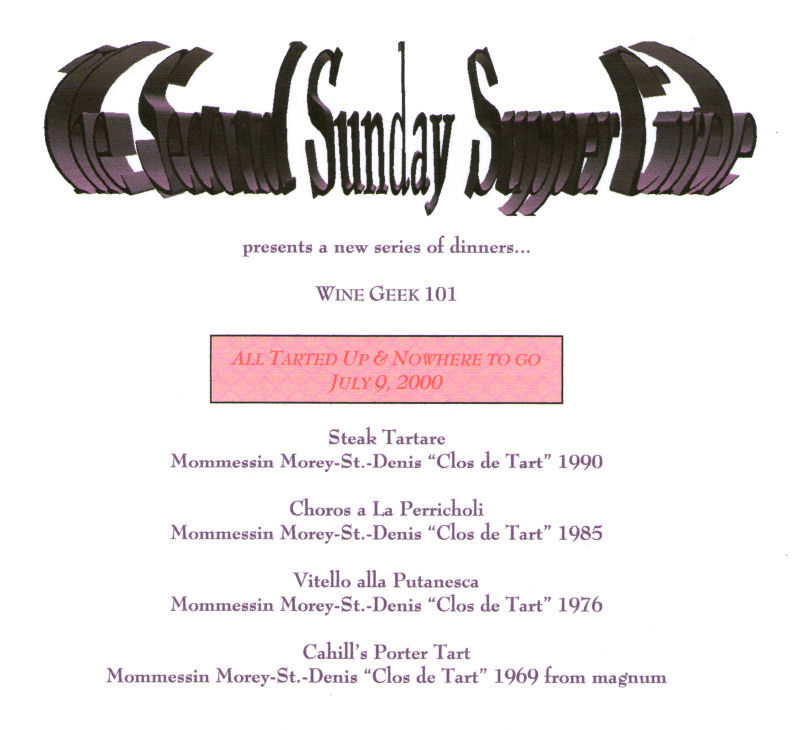 All I remember is that I’d picked up some bottles of different vintages of “Clos de Tart”, and invited a bunch of wine geek friends to sample them over dinner. The names of the dishes were plays on the word “tart”, as well.
All I remember is that I’d picked up some bottles of different vintages of “Clos de Tart”, and invited a bunch of wine geek friends to sample them over dinner. The names of the dishes were plays on the word “tart”, as well.